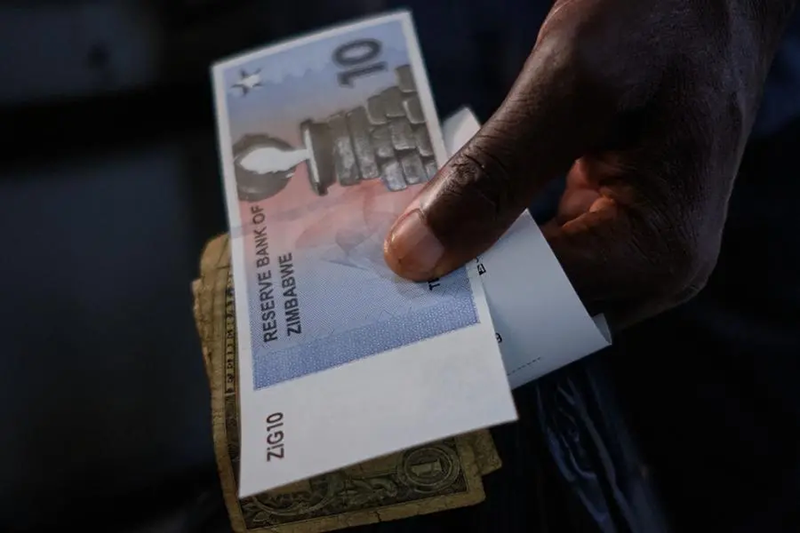- Finance
- No Comment
Zimbabwe’s sixth attempt at a new currency is floundering again

By Globe & Mail
In a jingle aired endlessly on Zimbabwean state television, an all-star singing group seems ecstatic about the country’s latest currency, known as the ZiG. “Everywhere you go, ZiG ho, ZiG ho,” they croon. “New money for you, new money for me.”
The gold-backed currency, officially known as Zimbabwe Gold, is “turning darkness into dawn,” the musicians sing in the video. “Nobody can stop the ZiG.”
But just six months after its introduction, the new currency is on its deathbed. Zimbabwe’s authorities abruptly devalued the currency by 43 per cent in late September, and its black-market value has tumbled even further since then, making a mockery of the government’s pledges of stability.
The new money – the sixth in Zimbabwe in the past 15 years – was launched in April in a bid to revive the moribund economy by replacing a series of failed currencies.
The banknotes feature reassuring-looking images of gold ingots, one of the country’s main exports. The government promised it would be a “solid and stable” currency, backed by gold and foreign currencies.
But the country’s independent journalists soon spotted the truth: Even Zimbabwe’s leaders preferred the U.S. dollar.
At rallies, President Emmerson Mnangagwa was seen reaching into his pocket and pulling out wads of U.S. cash, handing out US$100 bills to his supporters. One video showed him giving US$800 to an 80-year-old man who danced energetically at a memorial service. Zimbabweans, in online comments, ridiculed him for abandoning the ZiG.
Canada, meanwhile, warned its travellers that the new currency was rarely accepted on the street. “Most transactions in Zimbabwe are still made in U.S. dollars, so bring enough U.S. dollars to cover your stay,” it said in an official advisory to Canadian travellers earlier this year.

Zimbabwe has largely relied on the U.S. dollar since it suffered a disastrous bout of hyperinflation in 2009. At the peak of the crisis under former president Robert Mugabe, the monthly inflation rate was estimated at 80 billion per cent. The Zimbabwe dollar was printed in denominations of up to 100 trillion, which were soon worthless, becoming popular souvenirs for tourists.
Since then, each attempt to introduce a currency has floundered, reflecting a mismanaged economy where industry has largely collapsed, unemployment and inflation are persistently high, and interference by the authoritarian state is common. The ZiG’s predecessor, the mug, lost 80 per cent of its value this year alone.
When the ZiG was introduced, experts were sceptical. “ZiG failed before it was launched because it is not backed by sufficient reserves,” Zimbabwean economist Gift Mugano said in a social-media post a day after the announcement.
In the video jingle on state television, passengers were portrayed happily using the ZiG to pay their fare on minibuses. In reality, the transport system operates largely on U.S. dollars, since petrol stations refuse to accept ZiG payments.
Street vendors and small shops insist on U.S. cash from their customers because they are obliged to pay for supplies – and even their home rent – in the American currency. “I can’t risk accepting the ZiG because at the end of the day I will be stranded with the useless money,” said Raymond Musariwa, a 56-year-old shoe repairer in Harare.
A survey of 1,200 Zimbabweans by the Afrobarometer polling agency in June found that 62 per cent said they had little or no confidence that the ZiG would ease the country’s economic problems. Nearly 70 per cent said the government was performing “fairly badly” or “very badly” in managing the economy.
The government cracked down on black-market money dealers after the ZiG was introduced, but they soon reappeared, profiting from the ZiG’s weakness. Many dodged the police by using the encrypted messaging service WhatsApp to stay connected to their customers.

“This is our time to shine and this time the police won’t get us,” said Latwell Makarudze, an illegal money changer in Harare. “When the ZiG falls, we make more money because more people seek us to change their money instead of going to the banks.”
Universities were required to collect tuition payments in the new currency, but many students used street dealers to buy ZiG cash at a cheap price. “On the black market, instead of paying $470, I used only $219 to settle my fees,” said Luckmore Gwendoro, a political science student at the University of Zimbabwe. “I saved a lot of money.”
Supermarkets and other major retailers were obliged to post their prices in ZiG units at official rates, but many of their supplies had been procured in U.S. dollars at unofficial prices, so they suffered losses until they hiked their prices to match the black-market rate. Some shops have imposed a limit on how many ZiGs can be used daily by each customer.
“The situation is clearly untenable and will lead to company closures,” the Retailers Association of Zimbabwe warned in September.
The devaluation finally went ahead on Sept. 27, accompanied by a sharp hike in interest rates. The pain, this time, was felt by pensioners and civil servants who receive their wages and pensions in ZiGs, which lost 43 per cent of its official value in a single day. There was chaos in supermarkets as some shoppers abandoned their carts, suddenly unable to pay for goods.
“It is unlikely to be a one-time adjustment,” Oxford Economics warned in an analysis. The currency will continue to face “significant pressure,” it said.
In a speech to parliament this week, Mnangagwa issued a fresh barrage of threats to defend the ZiG.
“We note with concern the resurgence of parallel market activities driven by speculative tendencies,” he said, vowing that “corrective measures” would be taken against anyone who destabilized the new currency.
On the streets, however, vendors were demanding as much as 40 ZiGs per dollar, a rate even worse than the new official rate of 25 to the dollar.
